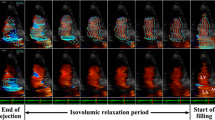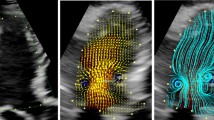Abstract
The effect of changes in stroke volume on the cross sectional velocity distribution in the mitral orifice during passive mitral inflow was studied in six patients with total atrioventricular block, atrial fibrillation and VVI pacemakers during periods with different heart rates. The time velocity integrals recorded both in the left ventricular outflow tract and at the mitral orifice decreased significantly as the heart rate was increased from 60 to 80 and from 80 to 100 beats per minute.
Instantaneous cross sectional flow velocity profiles were constructed by time interpolation of the velocity data from each point in sequentially delayed two dimensional digital ultrasound maps. Each patient had a characteristic cross sectional flow velocity profile in the mitral orifice recorded at the level of the leaflet tips in a four chamber view. The velocity profiles varied between the patients. With increase in heart rate only minimal changes in the flow profiles from individual patients were seen.
The maximum velocity through the mitral orifice overestimated the cross sectional mean velocity at the same time by a factor of 1.4–1.9. The maximum time velocity integral overestimated the cross sectional mean by a factor of 1.4–1.8. The observed cross sectional skew varied between patients but did not change significantly with increasing heart rate and decrease in stroke volume.
Similar content being viewed by others
References
Lewis JF, Kuo LC, Nelson JG, Limacher MC, Quinones MA. Pulsed Doppler echocardiographic determination of stroke volume and cardiac output: clinical validation of two new methods using the apical window. Circulation 1984; 70: 425–31.
Zhang Y, Nitter-Hauge S, Ihlen H, Myhre E. Doppler echocardiographic measurement of cardiac output using the mitral orifice method. Br Heart J 1985; 53: 130–6.
Goldberg SJ, Dickinson DF, Wilson N. Evaluation of an elliptical area technique for calculating mitral blood flow by Doppler echocardiography. Br Heart J 1985; 54: 68–75.
de Zuttere D, Touche T, Saumon G, Nitenberg A, Prasquier R. Doppler echocardiographic measurement of mitral flow volume: validation of a new method in adult patients. J Am Coll Cardiol 1988; 11: 343–50.
Hoit BD, Rashwan M, Watt C, Sahn DJ, Bhargava V. Calculating cardiac output from transmitral volume flow using Doppler and M-mode echocardiography. Am J Cardiol 1988; 62: 131–5.
Taylor DEM, Whamond JS. Velocity profile and impedance of the healthy mitral valve. In: Kalmanson D, editor: The mitral valve: a pluridisciplinary approach. Acton, Massachusetts: Publishing Sciences Group, Inc., 1976: 127.
Samstad SO, Torp HG, Linker DT, Rossvoll O, Skjaerpe T, Johansen E et al. Cross sectional early mitral flow velocity profiles from colour Doppler. Br Heart J 1989; 62: 177–84.
Linker DT, Johansen E, Torp H, Angelsen BAJ. Practical considerations and design of a digital system for aquisition of two-dimensional ultrasonic tissue and flow data. Echocardiography 1988; 5: 485–94.
Samstad SO, Torp HG, Matre K, Rossvoll O, Segadal L, Piene H. Instantaneous cross-sectional flow velocity profiles: A comparative study of two ultrasound Doppler methods applied to anin vitro pulsatile flow model. J Am Soc Echocardiogr 1990; 3: 451–64.
Glantz SA. Primer of biostatistics. 2nd ed. New York: McGraw-Hill, 1987.
Samet P, Bernstein WH, Medow A, Nathan DA: Effect of alterations in ventricular rate on cardiac output in complete heart block. Am J Cardiol 1964; 14: 477–82.
Segel N, Hudson WA, Harris P, Bishop JM. The circulatory effects of electrically induced changes in ventricular rate at rest and during exercise in complete heart block. J Clin Invest 1964; 43: 1541–50.
Rowe GG, Stenlund RR, Thomsen JH, Terry W, Querimit AS. Coronary and systemic hemodynamic effects of cardiac pacing in man with complete heart block, Circulation 1969; 40: 839–45.
Stewart WJ, Jiang L, Mich R, Pandian N, Guerrero JL, Weyman AE. Variable effects of changes in flow rate through the aortic, pulmonary and mitral valves on valve area and flow velocity: impact on quantitative Doppler flow calculations. J Am Coll Cardiol 1985; 6: 653–62.
Firth BG, Dehmer GJ, Nicod P, Willerson JT, Hillis LD. Effect of increasing heart rate in patients with aortic regurgitation. Am J Cardiol 1982; 49: 1860–7.
Author information
Authors and Affiliations
Rights and permissions
About this article
Cite this article
Samstad, S.O., Bathen, J., Rossvoll, O. et al. Impact of changes in heart rate and stroke volume on the cross sectional flow velocity distribution of diastolic mitral blood flow. Int J Cardiac Imag 8, 75–83 (1992). https://doi.org/10.1007/BF01137528
Accepted:
Issue Date:
DOI: https://doi.org/10.1007/BF01137528




